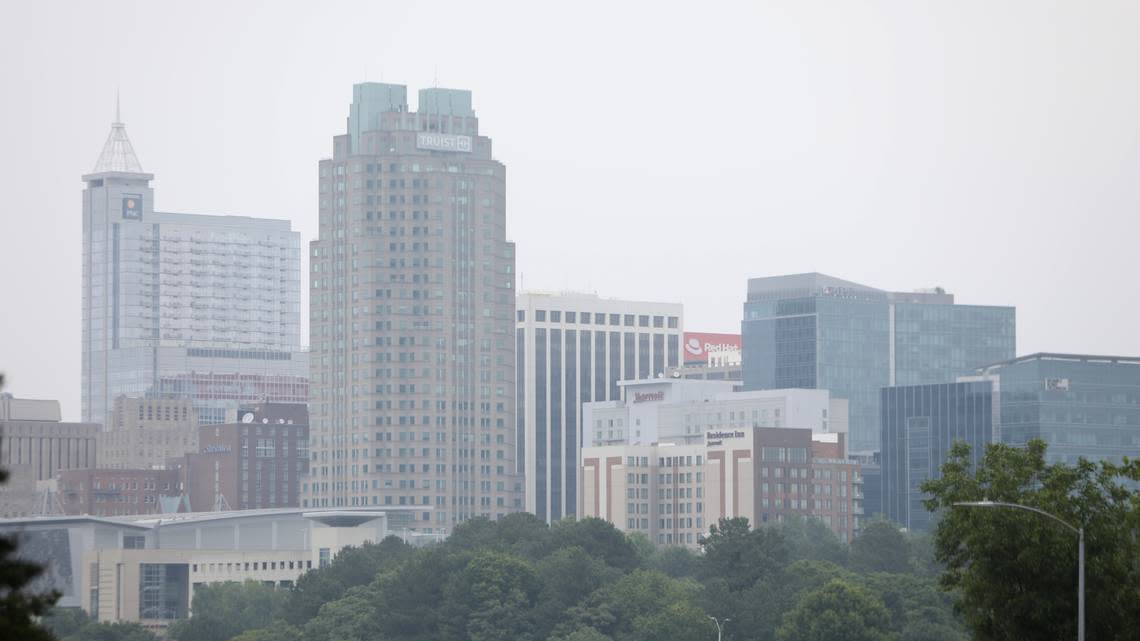The wildfire smoke plume you’re smelling could break up, but another is coming to NC
Air quality throughout North Carolina will remain at unsafe levels Thursday for those with respiratory problems, as smoke from wildfires in Canada continued to drift south.
The N.C. Division of Air Quality expects air to remain smoky Thursday, leading to a Code Orange for particulate matter. That means that older people, children and people with respiratory problems should avoid exerting themselves outdoor to limit exposure.
Fine particulate matter, also known as PM2.5, is of particular concern as the smoke hovers above the state. The air particles are about 30 times smaller than the width of a human hair and can cause short-term health effects like coughing and aggravating asthma.

“Air quality and smoke model guidance have been struggling with the complexity and behavior of this very challenging air quality episode,” the forecast said.
Another plume of wildfire smoke is making its way south, carrying more particulate matter and bringing more haze to North Carolina. The Division of Air Quality expects Code Orange conditions to last statewide through Friday.
Ozone levels are also expected to start rising Thursday, as chemicals in the wildfire smoke react with sunlight.
Both ozone levels and partculate matters are expected to remain at Code Yellow levels Saturday, according to DAQ.
Protection from wildfire smoke
People with respiratory diseases, cardiovascular diseases or diabetes, as well as people 65 and older, should especially take precautions to avoid interacting with particles from the wildfires.
“The simplest advice in general today is just to take it easy, but there are some people who appear to be at higher risk for adverse health outcomes today,” said Dr. David Peden, a pediatric allergist and immunologist with UNC Health who researches air pollution.

Wake County Parks, Recreation and Open Space has not canceled or altered any programming, but they are “keeping an eye on the situation,” said Wake County spokesperson Alice S. Avery.
The Wake County Public School System is advising students and faculty to heed the following guidelines, said WPSS communications officer Lisa Luten:
Schools are limiting outdoor activities, and students will take more breaks.
Schools are limiting “intense outdoor activities,” and they are rescheduling intense activities to another date or time.
Coaches and teachers are instructed to watch students for symptoms and “take action as needed.”
Wildfires are inextricably linked to the surrounding climate, Robert Scheller, N.C. State University’s associate dean of Natural Resources, told The News & Observer. They happen because a forest dried out over weeks or months, creating the fuel that a fire needs to burn once it is sparked.
While large fires like the one happening now or the large 2021 California fires that caused hazy air to reach North Carolina may have happened in the past, Scheller added, the frequency of large fires in boreal forests is increasing.
“It’s a combination of lack of precipitation and unusually high temperatures and those create the perfect conditions for fire,” Scheller said.
North Carolina isn’t immune from that increase. Scheller is part of a research team that’s studied large forests in the western part of the state and found that drier conditions expected in the future are likely to lead to more wildfires like the 2016 fires that burned more than 50,000 acres in North Carolina following a severe drought.
“Given climate change there is definitely going to be more wildfire in the future in North Carolina,” Scheller said. “There are management practices we can take to minimize the effects. But that always requires resources.”
Low pressure systems and ozone spikes
Particulate matter is measured in micrograms per cubic meter. Typically, North Carolina experiences levels in the high single digits or teens, said Elliot Tardif, a meteorologist with the N.C. Division of Air Quality. The three-person DAQ team works with meteorologists at the Forsyth County Office of Environmental Assistance & Protection, which measures air quality for a nine-county region in the Triad.
When the 24-hour average of the state’s measurement devices reaches 35.4 micrograms per cubic meter, the air is considered unsafe and officials issue a Code Orange. In addition to wildfires, controlled burns and even significant firework shows can cause particulate matter measurements to increase.
A low pressure system sitting off of New England and the Canadian coast has been preventing smoke from the large wildfires in Quebec and Ontario from reaching the Atlantic. Instead, it’s pushing that smoke south, Tardif said, down the Eastern seaboard and into the Mid-Atlantic region.
It is rare, Tardif said, for DAQ and other air quality officials to pre-emptively issue a Code Orange as far out as the rest of the week. But it was appropriate in this case, he said, because the low pressure system is expected to remain in place until Saturday or Sunday.
“We were reasonably confident of an impact or an event,” Tardif said.
Tardif also warned that wildfire smoke passing through the state could cause elevated levels of ozone as soon as Thursday. That happens, he said, because different elements in the smoke interact with nitric oxides and volatile organic compounds to increase ozone levels.
Ozone levels could be a particular concern around large cities like Charlotte, Durham and Raleigh, Tardif added. Those are places where pollutants from car exhaust pipes and other activities already tend to be higher than more rural areas.
If ozone levels do rise to unhealthy levels, that could also irritate lungs and aggravate asthma, according to the N.C. Department of Environmental Quality.
This is a developing story and will be updated through the day.
This story was produced with financial support from 1Earth Fund, in partnership with Journalism Funding Partners, as part of an independent journalism fellowship program. The N&O maintains full editorial control of the work.
